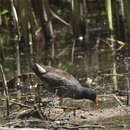fr
noms dans le fil d’Ariane


This species is known to some as the Florida gallinule, or the common gallinule
This species is territorial; therefore females use many antagonistic displays toward other females. A display of this species is seen as the low posture and the half opening the wings. After competition is finished, the female engages in bill dipping with the male, which signals courtship rituals. The female will also communicate acoustically that she is ready to mate with a murmur call.
Communication Channels: visual ; acoustic
Perception Channels: visual ; tactile ; acoustic ; chemical
Common moorhens are currently endangered in Hawaii (Hawaiian common moorhen, Gallinula chloropus sandvicensis), Guam, and the Northern Mariana Islands (Mariana common moorhen, Gallinula chloropus guami). In Hawaii this species was present on all five of the major islands, but is now only present on two. This is due to destruction and lack of good habitat for the birds. Other subspecies are not threatened or endangered. (Taylor, 1998; U.S. Fish and Wildlife, 2002). Common moorhens are listed as special concern in the state of Michigan.
US Migratory Bird Act: protected
US Federal List: endangered
CITES: no special status
State of Michigan List: special concern
IUCN Red List of Threatened Species: least concern
In some areas of the world the common moorhens are seen as a pest to crops. This species is an opportunistic feeder, which makes use of grain for food. In some instances they will feed in groups in agricultural areas.
Negative Impacts: crop pest
Species Used as Host:
Common moorhens feed while floating in water or walking on plants. In water the bird feeds by dipping its head and "surface sifting". It is an opportunistic feeder, which means that it eats the most abundant foods available. This species also feeds on land, gleaning insects or grazing for vegetation, cereals, or fruits.
Animal Foods: amphibians; fish; eggs; carrion ; insects; terrestrial non-insect arthropods
Plant Foods: leaves; seeds, grains, and nuts; fruit; flowers; bryophytes; algae
Primary Diet: omnivore
Common moorhens are widely distributed. In the United States, they are found year-round in California, Arizona, New Mexico and the Atlantic and Gulf coast states. They migrate and breed in the eastern half of the United States during the summer. They are also found throughout Mexico and Central America. The Common Moorhen is also found in South America, its range cutting through the middle of the continent from Brazil to Argentina and Peru. This species is also found year-round throughout Europe except Northern Scandinavia. From Europe it is migratory into Russia during the summer months. It is found also in India and the southern half of Asia south to the Philippine Islands. In Africa this species is only found in the area of South Africa, Madagascar, a large section of the Congo and Algeria.
Biogeographic Regions: nearctic (Native ); palearctic (Native ); oriental (Native ); ethiopian (Native ); neotropical (Native )
Common moorhens are found in many aquatic environments- man-made or natural, and in still or moving water. This species is partial to emergent aquatic vegetation which gives it adequate shelter. They are generally found in lowlands, up to 4575 m on passage though Nepal.
Range elevation: 0 to 4575 m.
Habitat Regions: temperate ; terrestrial ; freshwater
Aquatic Biomes: lakes and ponds; rivers and streams
Wetlands: marsh ; swamp
Other Habitat Features: urban ; suburban ; agricultural ; riparian
Common moorhens are fairly susceptible to nest predation or predation at a young age. The majority of birds die within the first year, and many of the remaining birds die in the second year.
Range lifespan
Status: wild: 11 (high) years.
Average lifespan
Status: wild: 126 months.
A medium to large sized gallinule. Dark gray to almost black in color, with a duller chin and throat. This species has white on the edges of the wings and rump. Legs are bright yellow-green. The bill of this species is yellow with a frontal shield that is bright red.
Range mass: 192 to 493 g.
Average mass: 300 g.
Range length: 30 to 38 cm.
Range wingspan: 50 to 55 cm.
Other Physical Features: endothermic ; homoiothermic; bilateral symmetry
Predators of adults are not specifically recorded. Predation is usually found during hatching and fledging. The charging attack is the most exploited tactic to discourage predators from taking young. The adult charges an intruder with its head held down. If the predator is too large to fend off, common moorhens will often flee and hide. This species has also been observed remaining submerged in water in the presence of a threat.
Known Predators:
Common moorhen mating behavior is unusual. Female competes in antagonistic behaviors with other females for copulation with males. The dominant female will chase the male in a courtship behavior. Copulation occurs on land and not in water.
Mating System: monogamous
Breeding occurs at any time in tropical regions and during warmer seasons of the year elsewhere. Typically, 5 to 9 eggs are produced.
Breeding season: Breeding season varies depending on latitude.
Range eggs per season: 2 to 12.
Range time to hatching: 17 to 22 days.
Average time to hatching: 20 days.
Range fledging age: 42 to 70 days.
Average fledging age: 50 days.
Average age at sexual or reproductive maturity (female): 12 months.
Average age at sexual or reproductive maturity (male): 12 months.
Key Reproductive Features: iteroparous ; seasonal breeding ; year-round breeding ; gonochoric/gonochoristic/dioecious (sexes separate); sexual ; oviparous
Average eggs per season: 9.
Incubation takes from 17 to 22 days, with a clutch size of 2 to 17. The male is reported to feed the female during incubation. Male moorhens are the prime incubator, but both sexes participate in incubation. Chicks upon hatching are precocial and nidifugous. These chicks are cared for and fed by both parents.
Parental Investment: precocial ; pre-fertilization (Provisioning, Protecting: Female); pre-hatching/birth (Protecting: Male, Female)